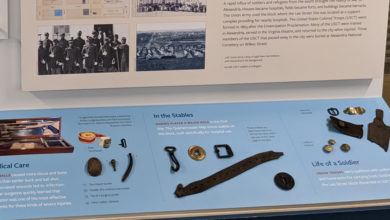THE TORPEDO FACTORY ARTS CENTER
“If our country is worth dying for in time of war let us resolve that it is truly worth living for in time of peace.” Hamilton Fish
By Jeff WInter
In a city like Alexandria, full of American history and historic sites, it is not often that you find something as special and as unique as the Torpedo Factory Arts Center. It is the only place that combines both a long historic past with a growing and highly respected contemporary time frame. The Torpedo Factory, and its 1974 renovation from a federal government-owned munitions factory to a state-of-the-art community arts center, has become one of Old Town Alexandria’s most visible and distinct focal points.
For many years, native Alexandrians remember the old buildings located on Union Street in the heart of Old Town as not only an eye sore, but a place where vandals, vagrants and teenagers would wonder its lonely, eerie long ramps and large open spaces. It was a place to look away from, not a place to look at, and certainly not a place to honor or revere. It finally took one of Alexandria’s most prominent citizens, Marian Van Landingham, with a strong vision and an extraordinary imagination to take the first steps to alter the old torpedo factory and mark its prominence forever. Not only to restore the old building into a place where artists of all kinds could work and display their hearts passions, but to remind us all of what the building was actually constructed for, and the thousands of people that worked there tirelessly beginning after the end of World War I.
The U.S. Navy began construction on the original building on November 12, 1918, ultimately becoming the U.S. Naval Torpedo Station, ironically the day after Armistice Day. For the next five years it was responsible for the manufacture and maintenance of torpedoes. When work stopped, the facility served as a munitions storage area until World War II. Production of a submarine borne torpedo called the Mark XIV, and the Mark III aircraft torpedo then resumed at an astounding rate. It is said that men and women worked around the clock and were given only two days off a year. As production needs increased, ten additional buildings were added to the complex.
The U.S. Navy’s green torpedo, used to practice[/caption]
According to the Torpedo Factory’s historic documents, the green torpedo currently displayed in the main hall was actually made here in 1945. This Mark XIV torpedo is painted bright green so that the Navy could find it in the water when it was tested. Its log book, in the exhibit case, tells its history and lists the submarines on which it traveled. At the end of World War II, work at the torpedo factory to construct war munitions stopped forever. After some time, the U.S. government decided to use the buildings for storage space. The military kept German war films and records in sealed vaults, Congress stored documents, and the Smithsonian stored art objects, and valuable dinosaur bones. The Torpedo Factory today, home to over 200 artists in residence. Courtesy photo.
Marian Van Landingham proposed a project that would renovate the building into working studio spaces for artists, several years after the City of Alexandria bought the complex from the federal government in 1969. Van Landingham was President of the Art League at the time, and her proposal was unanimously endorsed by the Commission. With Van Landingham’s experience in the arts, she was the obvious choice to become the first city-employed Director of the Art Center and the Torpedo Factory Artists’ Association. In 1974, work began on the building with artist volunteers and City personnel working together to remove 40 truckloads of debris, and studio walls were built, and electricity and plumbing were installed and the entire exterior was repaired and repainted. By July, the artists had converted the huge space into a complex of beautiful, bright beaming studios. On September 15, 1974, the Torpedo Factory Art Center opened to the public.
The building underwent a major renovation from 1982 to 1983, as part of the City’s waterfront development plan. According to the Torpedo Factory Art Center, today, it is home to over 160 professional artists who work, exhibit, and sell their art. Along with over 1,000 cooperative gallery members and some 2,000 art students, the Torpedo Factory Art Center draws artists from across the region, and attracts visitors from around the world who are welcome to visit with no admission fee. “It’s like coming into a museum in some ways,” said Dejan Jovanovic, a jewelry artist. “In our case, you not only get to see the fine, high quality art work, but you can walk in on say a Saturday and get to watch artists working on their latest piece and talk with them. There aren’t that many places in the world that you can do that.” Another artist, Lisa Schumaier, commented, “everyone here recognizes what a unique opportunity we have here at the Torpedo Factory and I think with that knowledge, we all push ourselves to do our best work, to really stretch our imagination.”
The Torpedo Factory Art Center has indeed become something truly stunning to look at, not to look away from, and a wonderful place to venture in and walk its now vibrant hallways and visit its culturally diverse artist studios. As the Torpedo Factory Arts Center promotes, it is truly “a working example of how the arts can revitalize a community and serves as a prototype for visual arts facilities throughout the world,” and it also embraces its long historical past, never letting us forget the thousands of men and women that worked there to help do their part during one of the most difficult periods in history.




